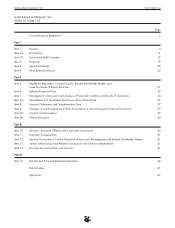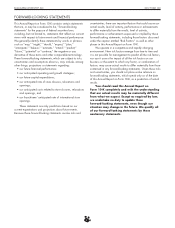Build-A-Bear Workshop 2012 Annual Report Download - page 20
Download and view the complete annual report
Please find page 20 of the 2012 Build-A-Bear Workshop annual report below. You can navigate through the pages in the report by either clicking on the pages listed below, or by using the keyword search tool below to find specific information within the annual report.
BUILD-A-BEAR WORKSHOP, INC. 2012 FORM 10-K
world website, bearville.com, achieve high enough traffic
levels nor be able to leverage the site to drive traffic to our
stores and choose to discontinue operating the site. Our future
growth and profitability will depend in large part upon the
effectiveness and efficiency of our marketing and advertising
programs and future marketing and advertising efforts that we
undertake, including our ability to:
• create greater awareness of our brand, interactive
shopping experience and products;
• identify the most effective and efficient level of spending
in each market;
• determine the appropriate creative message and media
mix for marketing expenditures;
• effectively manage marketing costs (including creative
and media) in order to maintain acceptable operating
margins and return on marketing investment;
• select the right geographic areas in which to market;
• convert consumer awareness into actual store visits and
product purchases; and
• reach a level of engagement on the virtual world Web
site with large numbers of unique visitors with frequent
visitation that drives visits to our retail stores resulting
in purchases.
Our planned marketing expenditures may not result in
increased total or comparable store sales or generate
sufficient levels of product and brand awareness. We may
not be able to manage our marketing expenditures on a
cost-effective basis.
If we are unable to increase our comparable store sales
trends, our results of operations and financial condition could
be adversely affected.
Our comparable store sales for 2012 declined 3.3%
following a 2.1% decline in 2011, following a 2.0% decline
in 2010, a 13.4% decline in fiscal 2009 and a 14.0%
decline in fiscal 2008. We believe that the decrease in 2012
was primarily attributable to a decline in transactions
compared to 2011, specifically in the third quarter and the
negative economic conditions in the UK that we believe
contributed to a decline in consumer spending. We believe
that the decrease in 2011 was primarily attributable to the
underperformance of certain licensed movie products in the
fourth quarter. We believe that global economic conditions
continued to impact our comparable store sales in 2010.
We believe that the decrease in fiscal 2009 was primarily
attributable to the continued economic recession and dramatic
decrease in consumer sentiment and the decline in
North American shopping mall traffic. We believe that the
decrease in 2008 was primarily attributable to the economic
recession and decrease in consumer disposable income,
a continued decline in shopping mall customer traffic and
changes in media strategies, online entertainment, children’s
media consumption and play patterns. We believe the
principal factors that will affect comparable store results
include the following:
• the continuing appeal of our concept;
• the effectiveness of our marketing efforts to attract new
and repeat guests;
• consumer confidence and general economic conditions;
• the impact of changes in governmental policies on
consumer sentiment and discretionary spending levels as
happened in the UK
• the impact of store closures, relocations and openings
in existing markets;
• the impact of our new store design;
• our ability to anticipate and to respond, in a timely
manner, to consumer trends;
• the continued introduction and expansion of our
merchandise offerings;
• mall traffic;
• competition for product offerings including in the online
space;
• the timing and frequency of national media appearances
and other public relations events; and
• weather conditions.
As a result of these and other factors, we may not be
able to generate or achieve comparable stores sales growth
in the future. If we are unable to do so, our results of
operations could be significantly harmed and we may be
required to record significant impairment charges.
Our strategy requires us to operate a significant number of
stores in the United States, Canada, the United Kingdom and
Ireland, as well as close, relocate and open store locations in
these countries. If we are not able to operate these stores or to
effectively manage the overall portfolio of our stores, it could
adversely affect our ability to grow and could significantly
harm our profitability.
Our future results will largely depend on our ability to operate
our stores successfully in the United States, Canada, the
United Kingdom and Ireland and optimizing store productivity
and profitability by closing select stores, relocating and
downsizing other stores and remodeling and opening select
stores in a new design. Through 2008 we had opened over
300 stores and acquired 40 in the UK. Since then we slowed
net store growth considerably with one net closure in both
2009 and 2010 and three net closures in 2011, exclusive of
temporary locations. In 2012, we announced a plan to
reduce our store count in North America to 225 to 250
stores. We plan to achieve this with 50 to 60 additional
closures by the end of 2014. This is in addition to the 10
locations closed in 2012 and 12 locations closed in 2011.
Our ability to manage our portfolio of stores in future years in
12
























